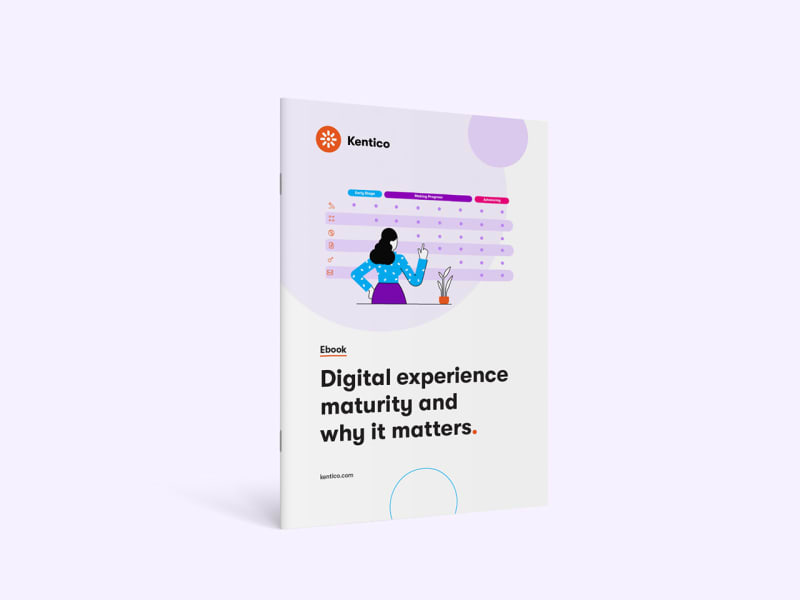Global spending on digital transformation is predicted to reach $2.8 trillion in 2025, more than double that of 2020. But how wisely invested are these dollars? Why do so many digital transformation efforts fail? We're exploring what digital experience maturity is. why understanding it crucial, and how to determine yours to promote digital growth and success.
What is digital experience maturity?
Digital experience maturity, refers to a company’s level of sophistication in measuring and delivering digital customer experiences across its touchpoints.
To achieve digital maturity, you need both the measuring and delivering components.
- You must first have visibility into the customer experiences you’re providing, i.e. an understanding of how your customers are behaving and feeling, and why.
- Then you must have the ability (technology and skill) to action these insights quickly and efficiently in order to iteratively improve the experience your customer has with your brand.
Together, these components create an infinite loop of learning and improvement and a stepladder towards excellence and agility in customer experience delivery.
Why is digital experience maturity important?
80% of customers are more likely to buy when offered personalized experiences and 74% based somewhat on experience alone!
It’s clear that simply attracting visitors to your website is no longer enough. Your online presence needs to deliver a stand-out personalized customer experience. You need to welcome, engage, impress, and nurture your potential consumers along the customer journey toward brand loyalty.
In order to build this kind of memorable experience, you need to truly understand who your audience is; where they are along the customer journey, what content they would most appreciate, which messages would best resonate, and which recommendations they would welcome.
With these valuable customer insights, you can start to craft the perfect experience of your brand, providing appropriate content, appealing messages, and specially-tailored recommendations for each of your visitors.
Digital experience maturity is linked to, but differs from, digital transformation. Digital transformation is about leveraging digital technologies and adjusting business processes, company culture, and customer experiences to improve efficiency, performance, and results. A key element of digital transformation is achieving increased business agility; the ability to adapt quickly to changing business and market requirements.
While digital transformation is about arming oneself with the tools that bring all these benefits, digital experience maturity is about understanding what the insights are telling you and being able to proactively and efficiently act on them in the context of your digital competitive environment.
Digital maturity is not just about having lots of tools, but about having the right tools for the job and about being able to leverage them to the full in order to achieve your specific goals. This requires a keen understanding of where you are digitally as a company, where you want to go, and what needs to happen in order for you to get there.
Much like a spotty teenager swamped in a too-big suit, eager to show the world how awesome he is, a company with digital immaturity can have big goals but may be trying to utilize a tool or process that it’s not yet equipped to leverage, resulting in poor adoption and lower overall efficiency and effectiveness that could stunt all its digital experience efforts.
A more digitally mature company is like a seasoned professional; comfortable in their skin, confident in their decisions, selective in where they place their efforts, and always ahead of the curve. Such a company is able to respond quickly to innovations and market changes. It will be constantly asking questions and inviting feedback. It will stay inquisitive of new technologies and well-informed of the market, customer, and competition. It will place a heavy focus on boosting collaboration and innovation. It will have a good understanding of its potential as well as its limitations. And it will arm itself with the appropriate technology and people for where it’s at to achieve its goals.
Digital maturity helps you get the most value out of your technology stack and to get the best results in the most efficient way. It brings a seamless flow of invaluable insights and a 360° view of your customer, as well as the knowledge of what to do with it and the tools to act on it. It gives you the agility to adapt to each visitor’s every whim almost before they have it.
Why understanding your level of digital maturity is key
So why should digital experience maturity be a key concern for marketers?
Because if you’re one step ahead of your customer, you’re creating win-wins for you and them at every turn. What better foundation to build a long-term relationship on?
The reason greater digital maturity leads to better customer relationships is because of the types of information you feed into your insights; you’re able to combine quantitative and qualitative data to powerful effect.
- Quantitative data (data gathered in measurable, numerical form) includes things like page views, bounce rates, most-viewed content, conversion rates, where visitors drop out of the funnel, etc. It provides the ‘what’ of user behavior and gives you an overall view of touchpoint performance.
- Qualitative data (based on observation and non-numerical insights) includes less tangible, richer metrics like session replays, direct feedback, and user testing. It provides the ‘why’ through insights into customer sentiment and motivation.
A focus entirely on quantitative data (the ‘what’) of customer behavior can lead to a significant gap in your understanding of the ‘why’ and therefore how to move forward. This approach can mean wasting precious resources and relationships on trial and error, rather than a more considered approach based on an authentic understanding of the ‘why’.
For instance, if one of your emails performs better than any to date, you might assume it’s because of the new design, when in fact it’s because of the eye-catching heading, or the timing, or the image… Quantitative data without qualitative data can result in you creating narratives to explain the ‘why’ of a ‘what’ when, there’s actually no data to support it.
On the other hand, without quantitative data, qualitative data can be misleading as it is typically derived from a sample group, and optimizing your entire approach based on just one group is likely to alienate other groups. Quantitative data keeps thing in perspective.
By combining these two data sets, you get a deeper understanding of who your customer is so you can move past mere conversion optimization toward digital experience optimization, boosting both conversions and customer lifetime value in one swoop.
Depending on where you’re at with your digital transformation and digital experience maturity journeys, you might consider tools such as:
- Marketing automation
- Content personalization
- Email marketing management
- Social media marketing
- Search engine optimization (SEO)
- A/B testing & website optimization
Of course, all your marketing tools should be seamlessly integrated if you’re going to derive anything of value from the data they collect. And your central solution has got to be designed to enable ultimate visibility and efficiency so you can act on your gathered insights with speed and skill.
That’s why understanding your level of digital experience maturity is key to your success. Having the wrong tools in the hands of the wrong people will only make you sluggish in response to time-critical stimuli. You must ensure you’re putting the right tools in the hands of the people who can get the most out of them and deliver staggering results.
So, let’s look at how to calculate the digital experience maturity of your company using a digital maturity index.
How to calculate digital experience maturity
As digital experiences directly impact the bottom line, knowing and understanding where you’re at with digital experience maturity is crucial.
We’ve created a simple, yet thorough Digital Growth Guide based on extensive research of how companies and their digital needs change as they grow. Presenting stages of digital maturity, which you can assess via 7 essential digital criteria; our guide helps you work out your current level of digital sophistication and figure out your next steps in your digital maturity journey.
Easy model to calculate digital experience maturity
Digital experience maturity is about getting the right technology in the hands of the right people and being able to take a more proactive approach to delivering an excellent customer experience.
If you’re looking to boost business and marketing performance, it’s time to focus on your digital experience maturity, ensuring both technical and organizational elements are appropriately aligned for your next move. To do this, you need a clear and honest understanding of where you’re at in order to get a good idea of what that next move should be.
Take the free digital maturity assessment and start your digital experience maturity journey today!
Want stronger digital performance? Start by understanding your platform’s maturity. Download our free ebook, Digital experience maturity and why it matters.


